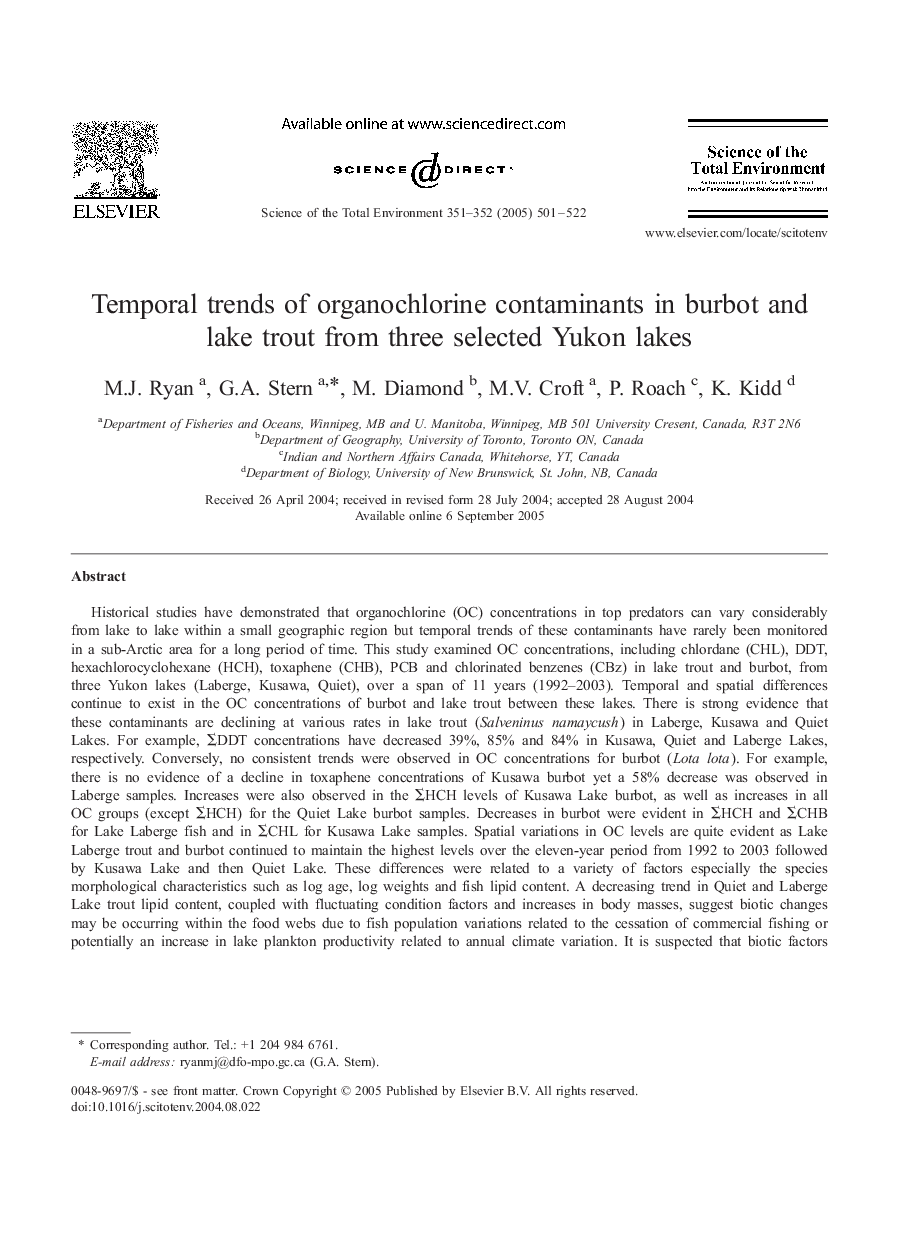| کد مقاله | کد نشریه | سال انتشار | مقاله انگلیسی | نسخه تمام متن |
|---|---|---|---|---|
| 10110582 | 1619987 | 2005 | 22 صفحه PDF | دانلود رایگان |
عنوان انگلیسی مقاله ISI
Temporal trends of organochlorine contaminants in burbot and lake trout from three selected Yukon lakes
دانلود مقاله + سفارش ترجمه
دانلود مقاله ISI انگلیسی
رایگان برای ایرانیان
کلمات کلیدی
موضوعات مرتبط
علوم زیستی و بیوفناوری
علوم محیط زیست
شیمی زیست محیطی
پیش نمایش صفحه اول مقاله

چکیده انگلیسی
Historical studies have demonstrated that organochlorine (OC) concentrations in top predators can vary considerably from lake to lake within a small geographic region but temporal trends of these contaminants have rarely been monitored in a sub-Arctic area for a long period of time. This study examined OC concentrations, including chlordane (CHL), DDT, hexachlorocyclohexane (HCH), toxaphene (CHB), PCB and chlorinated benzenes (CBz) in lake trout and burbot, from three Yukon lakes (Laberge, Kusawa, Quiet), over a span of 11 years (1992-2003). Temporal and spatial differences continue to exist in the OC concentrations of burbot and lake trout between these lakes. There is strong evidence that these contaminants are declining at various rates in lake trout (Salveninus namaycush) in Laberge, Kusawa and Quiet Lakes. For example, ΣDDT concentrations have decreased 39%, 85% and 84% in Kusawa, Quiet and Laberge Lakes, respectively. Conversely, no consistent trends were observed in OC concentrations for burbot (Lota lota). For example, there is no evidence of a decline in toxaphene concentrations of Kusawa burbot yet a 58% decrease was observed in Laberge samples. Increases were also observed in the ΣHCH levels of Kusawa Lake burbot, as well as increases in all OC groups (except ΣHCH) for the Quiet Lake burbot samples. Decreases in burbot were evident in ΣHCH and ΣCHB for Lake Laberge fish and in ΣCHL for Kusawa Lake samples. Spatial variations in OC levels are quite evident as Lake Laberge trout and burbot continued to maintain the highest levels over the eleven-year period from 1992 to 2003 followed by Kusawa Lake and then Quiet Lake. These differences were related to a variety of factors especially the species morphological characteristics such as log age, log weights and fish lipid content. A decreasing trend in Quiet and Laberge Lake trout lipid content, coupled with fluctuating condition factors and increases in body masses, suggest biotic changes may be occurring within the food webs due to fish population variations related to the cessation of commercial fishing or potentially an increase in lake plankton productivity related to annual climate variation. It is suspected that biotic factors rather than atmospheric inputs are the primary factors affecting the contaminant concentrations in lake trout and burbot in the study lakes.
ناشر
Database: Elsevier - ScienceDirect (ساینس دایرکت)
Journal: Science of The Total Environment - Volumes 351â352, 1 December 2005, Pages 501-522
Journal: Science of The Total Environment - Volumes 351â352, 1 December 2005, Pages 501-522
نویسندگان
M.J. Ryan, G.A. Stern, M. Diamond, M.V. Croft, P. Roach, K. Kidd,